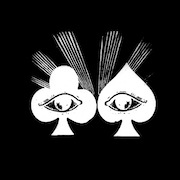It’s difficult to explore the music of Children of Alice without immediately thinking about Broadcast, and not because it occupies a similarly liminal space where the esoteric side of English folk meets the eerie electronics of the BBC Radiophonic Workshop. Children of Alice is, after all, a new(ish) project by Broadcast’s James Cargill and its very name stands as a tribute to the group’s late, lamented singer Trish Keenan, whose favourite book was Alice’s Adventures in Wonderland.
This debut album is arguably Cargill’s most significant work since the soundtrack to Peter Strickland’s giallo-inspired cult movie Berberian Sound Studio which served as something of an epitaph for Keenan and featured her last vocal contributions. But it owes more to Broadcast’s collaborative album with Ghost Box founder Julian House, Broadcast and The Focus Group Investigate Witch Cults of the Radio Age. Like that album, traditions of songcraft have been mutated beyond anything readily identifiable by the use of electronics, found sounds and effects until any sense of place or time becomes fractured and unreliable.
I first stumbled across Children of Alice, completely unaware of their identity as Cargil, House and another Ghost Box veteran Roj Stevens, via my discovery of the underrated research-project-cum-record-label Folklore Tapes, with the trio contributing a track to last year’s impressive compilation of music dedicated to midsummer rituals, Calendar Customs Vol. IV – Crown of Light. Their track from that set, ‘Invocation of a Midsummer Reverie’, is revived for Children of Alice, which effectively serves as a compilation of tracks Cargill and Stephens have been working on for the past few years. With a bold flourish, however, ‘Invocation’ is one of three tracks that make up fifty per cent of the album, and all are preceded by the colossal near-twenty minutes of ‘Harbinger of Spring’.
It’s an odd thought that a season celebrated as one of new beginnings and rebirth should come with a harbinger as if the planting season carries an undertone of dread and threat, but that’s precisely the atmosphere Children of Alice create through a tortured web of sampled voices, muted electronics and bursts of radio static. If the Broadcast and Focus Group album was a soundtrack to the weirdest of radio surfs, on ‘Harbinger of Spring’ Cargill and Stevens are navigating their way through wave lengths beamed up from England’s version of hades.
The track opens to muted, girlish voices humming and giggling over a mournful organ riffs, surrounded by birdsong. Then the birds fall silent, the organ recedes and for a brief moment all we’re left with is that phantomatic girl humming like the little kid in The Innocents singing ‘O Willy Waly’. Bells, chimes, cuckoo clocks samples, a mutated guitar and what sounds like a haunted carnival pulling up at the edge of a village all follow in a zigzagging path deeper and deeper into realms beyond the ether, the familiar radiophonic sounds that made Broadcast albums like Tender Buttons so beautiful now decidedly less welcoming. More voices emerge, adult but manipulated beyond recognition as definitely human and all folk flourishes are decidedly pagan in the Wicker Man sense of the word. It’s a dizzying concoction and a difficult brew to swallow but as its multiple layers peel back to reveal even more, the sinister seduction of ‘Harbinger of Spring’ begins to take effect. But for some reason I’m not looking forward to April as much as I was…
In comparison to the enormity of ‘Harbinger of Spring’, the three other pieces that make up the album – including the aforementioned ‘Invocation of a Midsummer Reverie’- are shorter and more overtly phantomatic. With titles like ‘Rite of the Maypole – An Unruly Procession’, one could assume that James Cargill and Roj Stephens have gone all Wicker Man in their attempts to navigate new and darker territory, but in reality, if film is to be a signpost, their vision exists in a dark yet hopeful liminal space where The Blood on Satan’s Claw meets Requiem for a Village. On the one hand, one can imagine these tracks, with their ever-shifting textures and use of disturbing sounds, operating in a dank theatre where pagan ritual reaches its most perturbed upper limits. On the other, they act as paeans to lost realms where the modern and the arcane intersect. These could be the rambunctious new towns evoked by the samples on ‘Rite of the Maypole – An Unruly Procession’ even as it conjures up mysterious folk traditions, or the more nebulous sonic congregations between electrical instrumentation and acoustic traditions that dominate ‘Invocation of a Midsummer Reverie’. Equally, the use of found and subsequently distorted vocals and field recordings bring to mind avant-garde artists like Trevor Wishart and Luc Ferrari. Again, listening to Children of Alice is an exercise in peeling a very mysterious onion.
On Children of Alice, James Cargill, Julian House and Roj Stevens take the past and attempt to refract its ghostly presence through new and old mediums. It takes a while for these disparate facets to show themselves fully, but the resultant experience is a trawl into an underworld totally removed from collective consciousness views of tradition, fate and religiosity. It’s a dark path, but one well worth taking, provided you have something to ease the headache when you come back.


